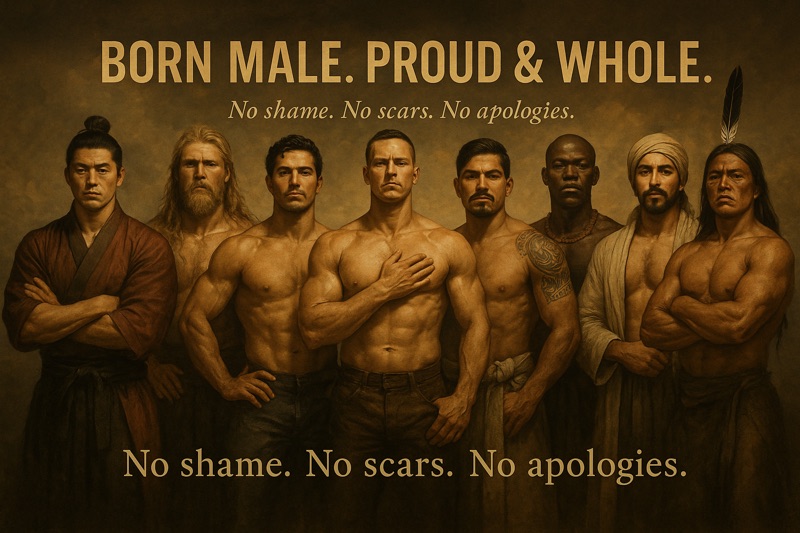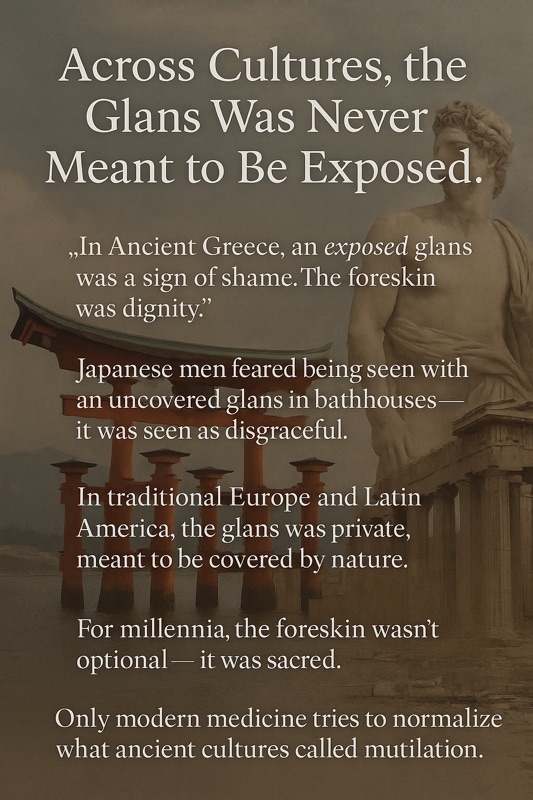Shameful Exposure: Why Many Cultures View the Circumcised Penis as Offensive
Shameful Exposure: Why Many Cultures View the Circumcised Penis as Offensive
The Untold Shame of the Exposed Glans Across Civilizations
By 𝘼𝙫𝙤𝙘𝙖𝙙𝙤𝙅𝙖𝙮23 | 𝘼𝙙𝙫𝙤𝙘𝙖𝙩𝙞𝙣𝙜𝘼𝙫𝙤𝙘𝙖𝙙𝙤
✌️💚🥑🍌 | “Genitals Shouldn’t Have Scars.”
⸻
Introduction: The Sacred Covering
For thousands of years, the foreskin was seen as normal, natural, even sacred in most of the world. It was a symbol of dignity, maturity, and bodily wholeness. But in recent history — particularly in the United States — that understanding was flipped.
Now, many are shocked to learn that in dozens of traditional and modern cultures, it’s not the foreskin that’s strange. It’s the exposed glans that’s considered shameful.
Across ancient and modern societies, the exposed glans — especially without a foreskin — is regarded as vulgar, indecent, even offensive. Circumcision, far from being a “norm,” is often seen as a violation of the body’s integrity and a source of social discomfort or stigma.
⸻
Foreskin = Dignity | Exposed Glans = Shame
“In many cultures, an exposed glans is seen as shameful — and circumcision is viewed as appalling, a mutilation of the body’s natural dignity.”
“Throughout history, the exposed glans was a symbol of shame — the foreskin was nature’s shield of honor.”
The foreskin has long been a mark of masculine grace, protection, and wholeness. Its removal — especially without consent — is seen as a brutal erasure of that natural state.
Why? Because the glans (head of the penis) is a sensitive, private organ.
Just like other intimate body parts, it was never meant to be exposed outside of urination or intimacy.
In many societies, displaying the glans publicly would be akin to flashing one’s genitals — it was considered deeply inappropriate.
⸻
Cultural Examples: Reverence for the Foreskin
Ancient Greece & Rome
• The foreskin (called posthe or akroposthion) was highly valued.
• A covered glans was seen as a sign of refinement and self-control.
• An exposed glans was shameful, indecent — only acceptable for slaves or prostitutes.
• Men would tie their foreskin shut with a cord (kynodesme) to ensure it stayed covered, even while nude in gymnasiums.
The Greeks saw circumcision as barbaric — a mutilation of the human form.
⸻
Japan
• Historically, circumcision was virtually unheard of.
• The exposed glans was considered a physical flaw or deformity.
• Men with naturally retractable foreskins sometimes felt ashamed of glans exposure.
• The term kanchō or mukebō literally meant “exposed glans” — a condition to be hidden.
Even today, Japan maintains low circumcision rates, with many viewing the practice as Western, unnecessary, and shame-based.
⸻
Jewish Culture (Ancient)
• Early Jewish circumcision was symbolic, not surgical — only a small nick, not full foreskin removal.
• Full glans exposure became mandatory only under Roman influence, which demanded complete removal for social and political control.
⸻
Islamic Societies
• While circumcision is common, modesty remains key.
• Public exposure of the glans is considered immodest and inappropriate.
• Many Muslim cultures emphasize privacy and dignity, not display or mutilation.
⸻
Regions Where the Glans Must Remain Covered
Across much of the world, it’s taboo to show the glans — even unintentionally.
Examples Include:
• Europe (France, Germany, Scandinavia, Spain): Intact men are the norm. Glans exposure seen as unnatural or rude.
• Latin America (Brazil, Argentina, Mexico): Most men are intact; circumcision is rare and often stigmatized.
• East Asia (China, Vietnam, Thailand, Japan): Historically opposed to body alteration; glans exposure viewed as indecent.
• Indigenous Tribes (Africa, Americas, Pacific Islands): Foreskin held cultural and spiritual significance. Exposure often taboo outside of rites.
⸻
Regions Where It’s Taboo to Be Circumcised
Yes — in many parts of the world, being circumcised is the taboo, not the other way around.
Circumcised men may be seen as:
• Mutilated or harmed
• Foreigners or outsiders
• Victims of religious or medical abuse
Specific Regions:
• Europe: In Denmark, Sweden, and Germany, routine circumcision is seen as unethical and unnecessary.
• China: Influenced by Confucian ideals, body alteration was discouraged — the body is a gift from one’s parents.
• Japan: Circumcision viewed as foreign, often linked to U.S. military influence post-WWII.
• Latin America: Circumcision is not culturally practiced and is often considered strange or undesirable.
⸻
In Contrast: Places Where Circumcision Is Expected
Some regions push circumcision through cultural, religious, or colonial pressures:
• United States: Rooted in anti-masturbation propaganda, class control, and corporate profit.
• South Korea: Influenced by U.S. military occupation.
• Jewish & Muslim communities: Religious tradition.
• Certain African tribes: Rites of passage.
But even in these regions, critical awareness is growing — many are now questioning the validity, ethics, and trauma of the practice.
⸻
The Manufactured Shame
“It’s a manufactured shame, not a real one. The only thing that changed was the narrative — not the anatomy.”
In truth, the foreskin has always been part of the male body — with over a dozen unique functions and biological purposes. But in the last 100 years, especially in America, the foreskin was rebranded as “dirty,” “useless,” or “disposable.”
This narrative has left millions of men:
• Defending their scars.
• Struggling with reduced sensation and identity.
• Unaware that their shame was manufactured — and their loss was real.
⸻
Conclusion: The World Remembers What America Forgot
The foreskin is not a flaw — it is a natural design of protection, dignity, and sensitivity.
An exposed glans without it is not a badge of pride — it is, in many cultures, a mark of violation.
Let’s stop pretending the rest of the world is backward for keeping what was never meant to be taken.
Let’s reclaim the truth — and our bodies — from the lies that tried to sever them.
⸻
Call to Action
If this opened your eyes, share it. Talk about it. Normalize the intact body.
Educate others — not out of shame, but out of truth and reclamation.
Foreskin = Wholeness.
Exposed Glans = Not Freedom, but Loss.
⸻
“The Foreskin Wasn’t a Mistake. The Shame Was Manufactured.”
Exposed Isn’t Natural. It’s a Violation.
Footnotes
- In Ancient Greece, the exposed glans was considered indecent, and men used the kynodesme (foreskin cord) to keep it hidden — even while nude in public gymnasiums.
- The term akroposthion referred to the long foreskin valued by Greeks and Romans as a sign of dignity and control.
- In traditional Japanese culture, circumcision was rare and glans exposure was called kanchō or mukebō, often causing shame or embarrassment in bathhouses.
- Ancient Jewish circumcision (brit milah) involved only a symbolic cut (milah), with the full removal (periah) added later under Roman influence.
- Confucian teachings emphasized preserving the body as a gift from one’s parents, discouraging body alterations like circumcision in traditional Chinese society.
- Most European, Latin American, and East Asian countries maintain low circumcision rates and consider intactness the norm; circumcision is often viewed as foreign or unnecessary.
- Routine circumcision in the United States began in the late 19th century as a “cure” for masturbation, later promoted for hygiene and cultural conformity.
- The U.S. and South Korea are two of the few countries that adopted widespread non-religious circumcision due to military and medical influence.
Works Cited / Suggested Sources
- Hodges, F. M. (2001). “The Ideal Prepuce in Ancient Greece and Rome.” British Journal of Urology International
- Glick, Leonard B. Marked in Your Flesh: Circumcision from Ancient Judea to Modern America. Oxford University Press, 2005.
- Denniston, George C., et al. Male and Female Circumcision: Medical, Legal, and Ethical Considerations in Pediatric Practice. Springer, 1999.
- Cold, C. J., & Taylor, J. R. (1999). “The Prepuce: Specialized Mucosa of the Penis and Its Loss to Circumcision.” British Journal of Urology International
- Kim, D., & Pang, M. G. (2007). “The Effect of Male Circumcision on Sexuality.” BJU International
- Hammond, T. (1999). “A Preliminary Poll of Men Circumcised in Infancy or Childhood.” Male and Female Circumcision: Medical, Legal, and Ethical Considerations, Springer.
- Wallerstein, Edward. Circumcision: An American Health Fallacy. Springer Publishing Company, 1980.
- #ForeskinFacts
- #GenitalIntegrity
- #EndCircumcision
- #BodilyAutonomy
- #ProtectTheForeskin
- #LeaveBoysIntact
- #CircumcisionAwareness
- #SayNoToCircumcision
- #GlobalIntactNorm
- #ForeskinIsNormal
- #CulturalWholeness
- #RespectTraditions
- #ExposedGlansTaboo
- #WorldViewsMatter
- #ShamefulExposure
- #NatureCoveredIt
- #TheGlansIsPrivate
- #ManufacturedShame
- #CutIsNotCute
- #WholenessWasSacred
- #RestoreTheTruth



📢 Want to Know the Truth?
👉 Watch Now: The Truth About Circumcision
Eric Clopper’s explosive, eye-opening presentation exposes the hidden truths about circumcision, its impact on men’s health, and the medical industry’s role in promoting it. If you care about bodily autonomy and human rights, this is a must-watch.
🔗 Sex & Circumcision: An American Love Story – Eric Clopper
🔗 https://youtu.be/FCuy163srRc?si=-I0uSf9MEV06b
Comments
Post a Comment